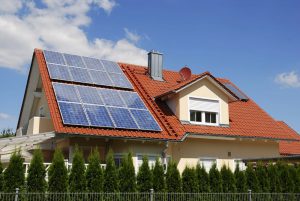 If you operate a commercial property in Arizona—dealership, warehouse, hotel, or municipal facility—you’re likely already aware that solar is one of the most compelling ways to reduce operating costs, hedge against rising electricity rates, and enhance property value. But 2026 may become the year that divides early movers from regretful latecomers.
If you operate a commercial property in Arizona—dealership, warehouse, hotel, or municipal facility—you’re likely already aware that solar is one of the most compelling ways to reduce operating costs, hedge against rising electricity rates, and enhance property value. But 2026 may become the year that divides early movers from regretful latecomers.
With new federal rules under the One Big Beautiful Bill Act tightening timelines and incentive windows, the solar market is rapidly shifting. Arizona businesses that wait risk missing key deadlines, elevated costs, supply chain bottlenecks, and reduced incentive eligibility.
In this article, we’ll walk through:
- What changes are coming in 2026
- How those changes affect Arizona solar projects
- What steps Arizona businesses should take now to avoid the rush
- And how EIP supports clients in locking in value, not losing it
1. What’s Changing: Key Deadlines & New Rules (National + Federal)
The federal clean energy incentive landscape is undergoing major reform. Under the new law, solar and related projects must satisfy stricter timing and sourcing rules to qualify for full credits. Among the most critical changes:
- Construction must begin by July 4, 2026, for most solar/wind projects to retain full tax credit eligibility (under safe harbor rules). Projects started later may be disqualified or receive reduced credits. Wikipedia+1
- Projects not begun by July 2026 typically must be placed in service by December 31, 2027, to maintain credit eligibility. Wikipedia+1
- New rules require stricter physical work tests rather than simply spending a percentage of costs to qualify as “beginning construction.” Wikipedia+2Arizona Mirror+2
- Equipment sourcing must comply with domestic content and “Foreign Entity of Concern (FEOC)” standards. Components from disqualified entities may void credits or bonus adders. Wikipedia+1
In other words: the window to secure full tax credits, bonus incentives, and favorable depreciation is compressing.
2. Arizona’s Solar Landscape & Incentive Context
While Arizona does not offer as many aggressive state-level solar incentives as some states, several relevant programs and rules affect commercial solar viability.
Arizona’s State-Level Incentives
- Commercial Solar Tax Credit (10 %)
Arizona businesses may be eligible for a state tax credit equal to 10% of installed costs, up to $25,000 per building. Greentech Renewables - Sales & Property Tax Exemptions
Solar equipment purchases are exempt from Arizona’s sales taxes, and in many cases, renewable energy property may benefit from favorable property tax treatment. Greentech Renewables - Residential Solar Credit (Not directly commercial)
For context, Arizona still offers a residential credit of 25% (up to $1,000) for solar systems. Resilient Arizona+2EnergySage+2
Challenges in Arizona
- Net Metering Dynamics
In Arizona, utilities and regulators are actively debating net metering terms and credit valuation for exported solar energy. Some utilities may favor lower compensation for exported energy (wholesale rates vs retail). Wikipedia - Interconnection Queue Congestion
Particularly in Phoenix, Tucson, and fast-growing suburbs, interconnection queues are becoming longer and more constrained. That makes early application and priority essential. - Hot Climate Efficiency
High heat can reduce module efficiency; designing systems for mitigation (cooling, high-efficiency modules, spacing) is more important in Arizona than in milder climates.
3. Why 2026 Will Be Arizona’s Solar Bottleneck
When the 2026 deadline looms, you’ll see a surge of solar projects racing to put shovels in the ground before tax rules shift. That surge will stress:
- Design & engineering capacity
- Permitting offices and AHJ reviews
- Interconnection queues
- Module, inverter, and battery supply chains
- Tax equity / financing markets
Arizona’s sun-rich environment makes the state an obvious candidate for heavy deployment—but that will also mean competition for resources, longer lead times, and higher costs. Waiting increases your risk of delays, missed credits, and squeezed margins.
4. The Cost of Delay: What You Stand to Lose
Let’s review what’s at stake for Arizona businesses that defer solar deployment:
- Loss or reduction of federal tax credits (30% ITC / 48E)
- Weaker depreciation value—you may lose or reduce bonus depreciation or shift to slower depreciation schedules
- Ineligibility for bonus adders if sourcing or domestic content rules tighten
- Higher installation and procurement costs, as suppliers and installers fill up
- Longer timelines—delays in permitting and supply chain bottlenecks
- Competitive disadvantage—other businesses adopt solar sooner and capture energy cost advantages
In a state where electricity demand and rates are high, missing several years of solar savings can accumulate into significant lost opportunity.
5. What Arizona Businesses Should Do Now to Beat the 2026 Rush
To stay ahead, Arizona commercial property owners should move proactively. Here’s a roadmap:
A. Kick Off Feasibility & Site Studies in Late 2025
Get solar potential studies, shading analysis, energy usage audits, and interconnection scoping going now.
B. Apply for Interconnection Early
Submit utility interconnect requests—especially in utility territories like SRP, APS, TEP—so you’re in the queue ahead of the rush.
C. Lock in Equipment and Contracts
Begin vendor selection, RFP issuance, and procurement commitments before supplier backlogs fill.
D. Document “Physical Work” Early
Perform on-site construction work (grading, foundations, racking) early enough to satisfy stricter “begin work” rules.
E. Plan for State + Federal Credit Stacking
Model with ITC (48E), depreciation (MACRS), and Arizona’s 10% credit + tax exemptions to maximize net returns.
F. Phase Construction Strategically
If full buildout is too large, deliver core segments first to hit deadlines, with room to expand later.
6. Sample ROI Snapshot for Arizona Solar Project with Timing Sensitivity
Here’s a hypothetical example for an Arizona commercial solar + battery project (e.g., 250 kW + 100 kWh):
| Total System Cost | $700,000 |
| Federal ITC (30%) | – $210,000 |
| Depreciation Tax Savings | – $140,000 |
| Arizona State 10% Tax Credit | – $35,000 |
| Sales/Property Tax Savings | – $30,000 (approx) |
| Net After-Incentive Cost | $285,000 |
| Annual Electricity + Demand Savings | $80,000+ |
| Payback Period | ~3.5 years |
| 25-Year Lifetime Savings | $1.8M+ |
If you miss the 2026 safe harbor or fail to begin construction in time, the $210,000 ITC could vanish—or be sharply reduced—pushing your payback out to 6–8 years instead.
7. How EIP Consulting Helps Arizona Businesses Stay Ahead
We don’t just install solar—we architect value-maximizing, risk-mitigated solar strategies. In Arizona, that includes:
- On-the-ground site assessment and solar + carport design
- Interconnection / utility scoping and queue strategy
- Incentive mapping (federal + Arizona add-ons)
- Procurement, construction oversight, and compliance documentation
- Full performance monitoring and maintenance support
Our consulting-first philosophy emphasizes capturing every dollar of incentives before deadlines, not just building systems.
Get Ahead of the Arizona Solar Rush
The 2026 solar deadline isn’t a distant concern—it’s right around the corner. With Arizona’s abundant sunlight and growing electricity costs, waiting means paying more and earning less.
Businesses that act now can secure the full 30% federal Investment Tax Credit, claim Arizona’s 10% state solar credit, and avoid the surge in project costs and utility interconnection delays expected in 2026.
At Energy Independence Professionals (EIP), we help Arizona businesses plan, finance, and execute solar projects that meet every eligibility window—so you can lock in maximum ROI without the rush.
Beat the deadline before the market does.
Schedule your Free Solar Incentive Review today to protect your place in the 2025 incentive window.
(619) 629-6556 | 🌐 energyindependenceprofessionals.com
